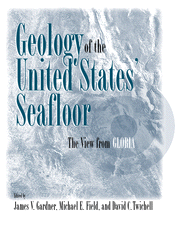Book contents
- Frontmatter
- Contents
- Contributors
- Foreword
- Introduction
- Part I The GLORIA System and Data Processing
- Part II U. S. East Coast EEZ
- Part III Gulf of Mexico and Caribbean EEZ
- Part IV U. S. West Coast EEZ
- Introduction
- 10 Discrimination of Fluid Seeps on the Convergent Oregon Continental Margin with GLORIA Imagery
- 11 A Meandering Channel at the Base of the Gorda Escarpment
- 12 The Morphology, Processes, and Evolution of Monterey Fan: A Revisit
- 13 Ground-Truth Studies of West Coast and Gulf of Mexico Submarine Fans
- 14 Morphology of Small Submarine Fans, Inner California Continental Borderland
- Part V Alaskan EEZ
- Index
13 - Ground-Truth Studies of West Coast and Gulf of Mexico Submarine Fans
Published online by Cambridge University Press: 25 January 2010
- Frontmatter
- Contents
- Contributors
- Foreword
- Introduction
- Part I The GLORIA System and Data Processing
- Part II U. S. East Coast EEZ
- Part III Gulf of Mexico and Caribbean EEZ
- Part IV U. S. West Coast EEZ
- Introduction
- 10 Discrimination of Fluid Seeps on the Convergent Oregon Continental Margin with GLORIA Imagery
- 11 A Meandering Channel at the Base of the Gorda Escarpment
- 12 The Morphology, Processes, and Evolution of Monterey Fan: A Revisit
- 13 Ground-Truth Studies of West Coast and Gulf of Mexico Submarine Fans
- 14 Morphology of Small Submarine Fans, Inner California Continental Borderland
- Part V Alaskan EEZ
- Index
Summary
Introduction
The use of sidescan sonar technology has greatly expanded in recent years. One impediment to interpreting sidescan sonar images, which are a representation of the amount of sound backscattered from the seafloor, is the incomplete understanding of the physical meaning of acoustic backscatter intensity variations. Ground-truth studies can help us to understand the causes of variations in backscatter. We need to measure physical and geometric properties of seafloor sediment and correlate them with variations in sidescan sonar acoustic backscatter. We present in this paper comparative ground-truth studies of two deep-sea fan depositional lobes. We show that sediment lithology influences sidescan sonar images, but that the relation between backscatter intensity and sediment grain size is not uniquely defined.
Some of the seafloor characteristics that are potential causes of variations in acoustic backscatter intensity are surface roughness, variations in sediment composition, grazing angle of insonification, and seafloor slope, including topographic variability (Urick 1983). The influence of each of these and the subbottom depth range over which sediment compositional variations are important will vary with the characteristics of the sidescan system, including frequency, pulse length, bandwidth, time-varying gains, and footprint size. The number of variables needs to be kept to a minimum in order to simplify a ground-truth study. The distal parts of deep-sea fans are good locations for such studies because they tend to have nearly horizontal seafloor surfaces. Thus, the topographic variability – bottom slope effect can be ignored.
- Type
- Chapter
- Information
- Geology of the United States' SeafloorThe View from GLORIA, pp. 221 - 234Publisher: Cambridge University PressPrint publication year: 1996



